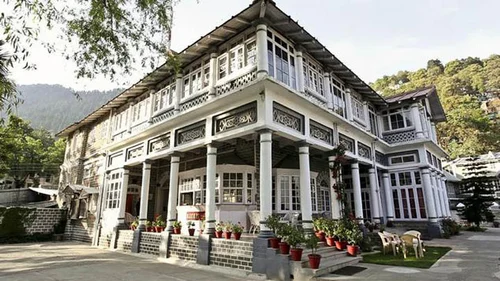Perched gracefully on the slopes of Ayarpatta Hill, overlooking the shimmering waters of Naini Lake, stands one of Nainital’s best-kept secrets—Belvedere Palace. Once the royal summer residence of the Raja of Awagarh, this elegant estate tells the story of princely leisure, colonial encounters, and quiet Himalayan grandeur.
🌿 Setting the Scene
Nestled amidst towering oaks and deodars, Belvedere offered the perfect retreat from the blazing heat of the northern plains. As Nainital rose to fame in the 19th and early 20th centuries as a premier hill station for British officers and Indian nobility alike, the Rajas of Awagarh, a princely state in present-day Uttar Pradesh, established their summer abode here.
Much like the Raj Bhavans of colonial India, Belvedere was more than just a palace—it was a statement of status, style, and presence in a town where colonial governors and princely rulers mingled with poets, mountaineers, and missionaries.
👑 The Royal Connection: Raja of Awagarh
The Awagarh estate was among the oldest and most distinguished jagirs of the region. The rulers were known for their refined tastes, patronage of the arts, and progressive mindset. Belvedere Palace was commissioned by the family not only as a seasonal home but also as a cultural anchor in Nainital’s social fabric.
It is said that the palace played host to evenings of music, shikar tales, and diplomatic tea-parties attended by British officials and fellow royals from Alwar, Rampur, and Bhopal.
🏛️ Architecture & Interiors
Belvedere Palace is an exquisite example of Anglo-Indian hill architecture, combining colonial elements with Indian sensibilities.
Notable Features:
-
Gabled roofs and tall windows designed to let in the mountain breeze.
-
Wide verandahs for lounging during golden sunsets.
-
Vintage fireplaces in richly panelled drawing rooms.
-
Ornate staircases and wooden beams—hallmarks of late-Raj elegance.
-
Terraced gardens that slope gently towards the lake, once manicured in the style of English botanical parks.
Even in its quieter years, the palace retains a quiet dignity, wrapped in pine-scented mist and the gentle calls of hillside birds.
🕰️ Through the Ages
Following Independence and the decline of princely privilege, Belvedere, like many royal properties, went through changes. Parts of the estate were either sold, leased, or repurposed. For a while, it served government or semi-public functions, but unlike many heritage sites, it retained its structural integrity and original charm.
Some reports also suggest that films and documentaries may have been shot in and around Belvedere due to its authentic colonial aura.
🌄 Belvedere Today
Though not always open to public access, Belvedere Palace continues to intrigue travelers, history lovers, and architecture enthusiasts. For locals and older residents of Nainital, it remains a landmark rich in stories—of royal picnics, elegant carriages, and velvet evenings by the fire.
Efforts have been occasionally discussed to restore and convert it into a boutique heritage hotel or museum, though such plans remain unconfirmed.
📚 A Palace Worth Remembering
Belvedere is more than a physical structure—it’s a memory. Of a time when summer was spent in the hills, when the air was filled with the scent of rhododendrons and the soft rustle of silk sarees and sherwanis at lakeside soirées.
In a town bustling with tourists and modern cafes, Belvedere Palace stands as a quiet witness to Nainital’s royal and colonial legacy.
✨ Conclusion
Belvedere Palace, Nainital, remains one of the last living testaments to the era of summer hill retreats and princely dignity. Though time has softened its glow, it still casts a long shadow across Nainital’s history—dignified, distant, yet unforgettable.
To know Belvedere is to discover a forgotten heartbeat of royalty in the hills.

